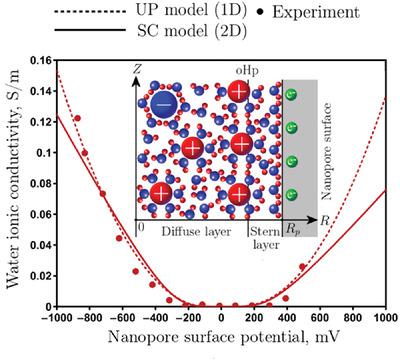当前位置:
X-MOL 学术
›
Adv. Theory Simul.
›
论文详情
Our official English website, www.x-mol.net, welcomes your feedback! (Note: you will need to create a separate account there.)
Ionic Conductivity of Nanopores with Electrically Conductive Surface: Comparison Between 1D and 2D Models
Advanced Theory and Simulations ( IF 3.3 ) Pub Date : 2021-09-03 , DOI: 10.1002/adts.202100174 Artur I. Krom 1 , Ilya I. Ryzhkov 1, 2
Advanced Theory and Simulations ( IF 3.3 ) Pub Date : 2021-09-03 , DOI: 10.1002/adts.202100174 Artur I. Krom 1 , Ilya I. Ryzhkov 1, 2
Affiliation

|
Nanoporous membranes with high ionic conductivity are advantageous in such electrochemical processes as (reverse) electrodialysis, capacitive deionization, and hydrogen energy conversion. In membranes with electrically conductive surface, the conductivity can be regulated by varying the surface potential. This work is devoted to the theoretical study of switchable ionic conductivity. The transport of ions is described by the 2D space charge model and 1D uniform potential model taking into account the Stern layer. The conductivity decreases with lowering the Stern layer permittivity due to enhanced screening of electronic surface charge. The growth of surface potential leads to the conductivity enhancement due to accumulation of more counter-ions inside the nanopore. For nanopores with constant surface charge density, the ionic conductivity follows the bulk electrolyte conductivity at high ion concentrations, and becomes independent of concentration when the latter is low. In contrast, the nanopores with constant surface potential demonstrate a linear decrease of conductivity with lowering the logarithm of ion concentration. The deviation between 1D and 2D models becomes noticeable at higher values of Stern layer permittivity, pore radius, electrolyte concentration, and surface potential. The proposed models are verified by comparison with experimental data on pure water conductivity in charged porous matrix.
中文翻译:

具有导电表面的纳米孔的离子电导率:一维和二维模型之间的比较
具有高离子电导率的纳米多孔膜在(反向)电渗析、电容去离子和氢能转换等电化学过程中具有优势。在具有导电表面的膜中,可以通过改变表面电位来调节电导率。这项工作致力于可切换离子电导率的理论研究。考虑到 Stern 层,离子的传输由 2D 空间电荷模型和 1D 均匀电位模型描述。由于电子表面电荷的屏蔽增强,电导率随着 Stern 层介电常数的降低而降低。由于纳米孔内积累了更多的反离子,表面电位的增长导致电导率增强。对于具有恒定表面电荷密度的纳米孔,离子电导率在高离子浓度时遵循本体电解质电导率,当后者低时变得与浓度无关。相比之下,具有恒定表面电位的纳米孔表现出电导率随着离子浓度对数的降低而线性下降。一维和二维模型之间的偏差在 Stern 层介电常数、孔隙半径、电解质浓度和表面电位值较高时变得明显。通过与带电多孔基质中纯水电导率的实验数据进行比较,验证了所提出的模型。具有恒定表面电位的纳米孔表明,随着离子浓度对数的降低,电导率呈线性下降。一维和二维模型之间的偏差在 Stern 层介电常数、孔隙半径、电解质浓度和表面电位的值较高时变得明显。通过与带电多孔基质中纯水电导率的实验数据进行比较,验证了所提出的模型。具有恒定表面电位的纳米孔表明,随着离子浓度对数的降低,电导率呈线性下降。一维和二维模型之间的偏差在 Stern 层介电常数、孔隙半径、电解质浓度和表面电位的值较高时变得明显。通过与带电多孔基质中纯水电导率的实验数据进行比较,验证了所提出的模型。
更新日期:2021-10-04
中文翻译:

具有导电表面的纳米孔的离子电导率:一维和二维模型之间的比较
具有高离子电导率的纳米多孔膜在(反向)电渗析、电容去离子和氢能转换等电化学过程中具有优势。在具有导电表面的膜中,可以通过改变表面电位来调节电导率。这项工作致力于可切换离子电导率的理论研究。考虑到 Stern 层,离子的传输由 2D 空间电荷模型和 1D 均匀电位模型描述。由于电子表面电荷的屏蔽增强,电导率随着 Stern 层介电常数的降低而降低。由于纳米孔内积累了更多的反离子,表面电位的增长导致电导率增强。对于具有恒定表面电荷密度的纳米孔,离子电导率在高离子浓度时遵循本体电解质电导率,当后者低时变得与浓度无关。相比之下,具有恒定表面电位的纳米孔表现出电导率随着离子浓度对数的降低而线性下降。一维和二维模型之间的偏差在 Stern 层介电常数、孔隙半径、电解质浓度和表面电位值较高时变得明显。通过与带电多孔基质中纯水电导率的实验数据进行比较,验证了所提出的模型。具有恒定表面电位的纳米孔表明,随着离子浓度对数的降低,电导率呈线性下降。一维和二维模型之间的偏差在 Stern 层介电常数、孔隙半径、电解质浓度和表面电位的值较高时变得明显。通过与带电多孔基质中纯水电导率的实验数据进行比较,验证了所提出的模型。具有恒定表面电位的纳米孔表明,随着离子浓度对数的降低,电导率呈线性下降。一维和二维模型之间的偏差在 Stern 层介电常数、孔隙半径、电解质浓度和表面电位的值较高时变得明显。通过与带电多孔基质中纯水电导率的实验数据进行比较,验证了所提出的模型。


























 京公网安备 11010802027423号
京公网安备 11010802027423号